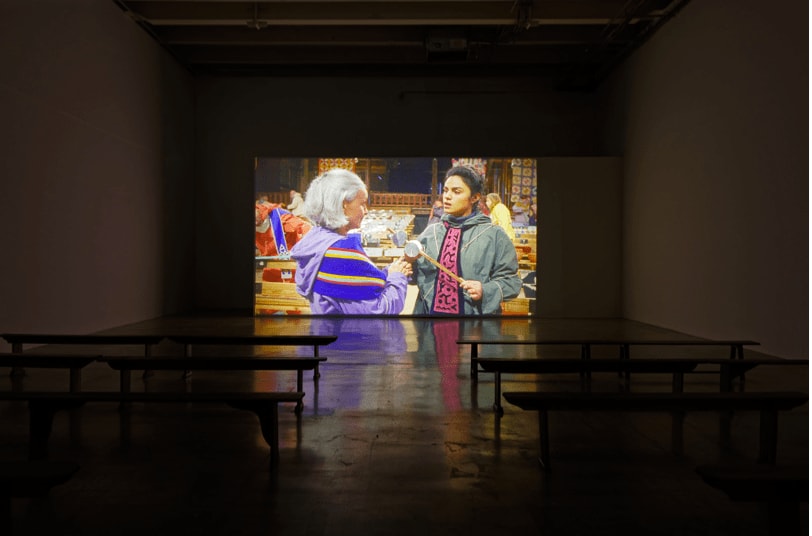
Ulla von Brandenburg
Le milieu est bleu, 2020
16mm colour film, HD video transfer
23’43”
Edition of 5 plus 2 artist's proofs
Copyright The Artist
Further images
“What is a community? The people does not exist in and of itself. I think we are all quite alone today. What do groups cohere around? Are there other possibilities...
“What is a community? The people does not exist in and of itself. I think we are all quite alone today. What do groups cohere around? Are there other possibilities for living?”
With this video shot on 16mm colour film, Ulla von Brandenburg transports the visitors into new surroundings. They find themselves in the Théâtre du Peuple in Bussang, a theatre built on a mountainside in the Vosges at the end of the 19th century to host theatrical festivities for the people. It is within this space infused with humanist ideals that Ulla von Brandenburg sets her performers, who sing a text inspired by the 1930 play The Deep-Sea Fish (Der Tiefseefisch) by Marieluise Fleisser (1901-1974). They act out a “micro-society, as if it were the last of its kind”: a living community cut off from the outside world, with its own economy, rules, and values. Their daily life is suddenly interrupted when one of the group’s members breaks with the ritual and opens the doors of the décor. They reveal to the spectator the specificity of the Bussang theatre – the back of the stage opens up directly onto the forest – and at the same time reveal to their community the possibility of contact with the outside world. The film offers at once a variation on ideas of loss, abandonment and flight, and a tale that reflects upon the themes of transgression and individual responsibility within the collective.
At the end of the film, the members of the community disappear only to reappear within the Palais de Tokyo; the objects they bring with them become the works of the exhibition. Ulla von Brandenburg thus reveals the illusory nature of theatre and, like the bear that unexpectedly appears in her film, thrusts into the midst of our social organisation that which it strives to exclude: nature, and the unknown.
With this video shot on 16mm colour film, Ulla von Brandenburg transports the visitors into new surroundings. They find themselves in the Théâtre du Peuple in Bussang, a theatre built on a mountainside in the Vosges at the end of the 19th century to host theatrical festivities for the people. It is within this space infused with humanist ideals that Ulla von Brandenburg sets her performers, who sing a text inspired by the 1930 play The Deep-Sea Fish (Der Tiefseefisch) by Marieluise Fleisser (1901-1974). They act out a “micro-society, as if it were the last of its kind”: a living community cut off from the outside world, with its own economy, rules, and values. Their daily life is suddenly interrupted when one of the group’s members breaks with the ritual and opens the doors of the décor. They reveal to the spectator the specificity of the Bussang theatre – the back of the stage opens up directly onto the forest – and at the same time reveal to their community the possibility of contact with the outside world. The film offers at once a variation on ideas of loss, abandonment and flight, and a tale that reflects upon the themes of transgression and individual responsibility within the collective.
At the end of the film, the members of the community disappear only to reappear within the Palais de Tokyo; the objects they bring with them become the works of the exhibition. Ulla von Brandenburg thus reveals the illusory nature of theatre and, like the bear that unexpectedly appears in her film, thrusts into the midst of our social organisation that which it strives to exclude: nature, and the unknown.
